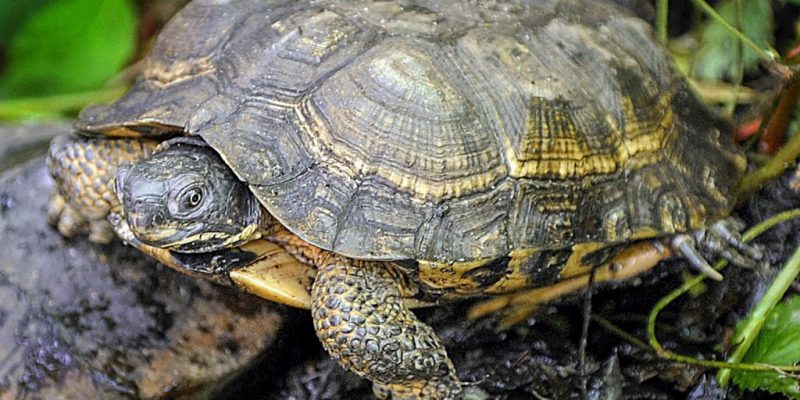
When I moved from New Paltz to my Gardiner apartment over four years ago, I immediately sized up the habitats that surrounded my new home. Forest across the road…perfect for owls, woodpeckers, and warblers. Fields in the back…excellent for courting woodcocks and foraging foxes. Creek out front…probably inhabited by northern two-lined salamanders and other amphibians. I felt as though I had landed in a biodiverse hotspot —my kind of place! But what sent my wildlife radar into overdrive was the connected landscape of forest, field, and creek. Was it possible I would have wood turtles as neighbors?!
The wood turtle (Glyptemys insculpata) is a semi-aquatic species, spending part of its life cycle on land and part in the water. It requires different habitats, and needs to be able to move safely from one habitat type to another. In the summer, wood turtles feed in forests and fields; in the winter, they hibernate in creeks; and in the spring, they are typically found in streamside habitats and can utilize a home range area that includes up to a half-mile stretch of stream corridor.
Wood turtles are medium-sized, brown turtles with bright orange, yellow, or red skin on the neck, forelimbs and tail. The species is distinguished by its upper shell (carapace), on which each scale (scute) resembles a sculpture of low, ridged pyramids—thus the species name insculpata or “sculpted.” The lower shell (plastron) is mostly yellow, with large black blotches on the outer, posterior corner of each scute that form a pattern unique to each individual. They begin breeding at around 14-18 years of age, and can live to about 50-60 years old. Wood turtles are known for their “stomping” behavior while searching for food. They stomp their front feet to create vibrations underground that resemble rainfall and draw earthworms to the surface—where they quickly become the wood turtle’s next meal.
So, was I correct that I might be living in wood turtle habitat? On a June evening in 2007, on my way to the composter, I froze in my tracks—there in the grass was a female wood turtle! Looking for a place to dig her nest, she must have been attracted to the exposed soil in a recently-excavated part of the yard. I slowly sat down and, keeping very still, watched as she searched for the perfect nest site. Unfortunately, most wood turtle nests are dug up and destroyed by opportunistic predators like raccoons and skunks, which eat reptile eggs and easily coexist with humans.
Other threats to wood turtles include mortality while crossing roads and agricultural fields, and the fact that they are collected as pets or for commercial trade. With all these challenges to their survival, it’s no wonder they are listed as a Species of Special Concern in New York.
What can we do? Use caution while driving, mowing and farming during seasons of active movement by wood turtles. If you see a turtle crossing the road (and it’s safe for you to cross), pick up the turtle and move it to the other side in the same direction it was traveling. Don’t be tempted to take it home for a pet! And most importantly, help to educate your family, neighbors, landowners, and community leaders so that Gardiner can continue to provide habitat for the wood turtles that live here, and for their hatchlings which will emerge from underground nests next fall.
